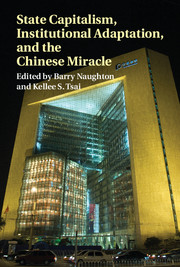62 results
20 - The Chinese Economy in the Reform Era
- from Part II - 1950 to the Present
-
-
- Book:
- The Cambridge Economic History of China
- Published online:
- 07 February 2022
- Print publication:
- 24 February 2022, pp 722-774
-
- Chapter
- Export citation
Contributors
-
- Book:
- State Capitalism, Institutional Adaptation, and the Chinese Miracle
- Published online:
- 05 June 2015
- Print publication:
- 09 June 2015, pp xii-xiii
-
- Chapter
- Export citation
Dedication
-
- Book:
- State Capitalism, Institutional Adaptation, and the Chinese Miracle
- Published online:
- 05 June 2015
- Print publication:
- 09 June 2015, pp v-v
-
- Chapter
- Export citation
Section II - Outcomes and Processes
-
- Book:
- State Capitalism, Institutional Adaptation, and the Chinese Miracle
- Published online:
- 05 June 2015
- Print publication:
- 09 June 2015, pp 73-198
-
- Chapter
- Export citation
Section III - The Big Picture: Historical, Social, and Systemic Perspectives
-
- Book:
- State Capitalism, Institutional Adaptation, and the Chinese Miracle
- Published online:
- 05 June 2015
- Print publication:
- 09 June 2015, pp 199-264
-
- Chapter
- Export citation
Contents
-
- Book:
- State Capitalism, Institutional Adaptation, and the Chinese Miracle
- Published online:
- 05 June 2015
- Print publication:
- 09 June 2015, pp vi-viii
-
- Chapter
- Export citation
Index
-
- Book:
- State Capitalism, Institutional Adaptation, and the Chinese Miracle
- Published online:
- 05 June 2015
- Print publication:
- 09 June 2015, pp 265-278
-
- Chapter
- Export citation
Acronyms
-
- Book:
- State Capitalism, Institutional Adaptation, and the Chinese Miracle
- Published online:
- 05 June 2015
- Print publication:
- 09 June 2015, pp xiv-xv
-
- Chapter
- Export citation
Acknowledgements
-
- Book:
- State Capitalism, Institutional Adaptation, and the Chinese Miracle
- Published online:
- 05 June 2015
- Print publication:
- 09 June 2015, pp xvi-xviii
-
- Chapter
- Export citation
Tables
-
- Book:
- State Capitalism, Institutional Adaptation, and the Chinese Miracle
- Published online:
- 05 June 2015
- Print publication:
- 09 June 2015, pp ix-x
-
- Chapter
- Export citation
1 - Introduction
-
-
- Book:
- State Capitalism, Institutional Adaptation, and the Chinese Miracle
- Published online:
- 05 June 2015
- Print publication:
- 09 June 2015, pp 1-24
-
- Chapter
- Export citation
Figures
-
- Book:
- State Capitalism, Institutional Adaptation, and the Chinese Miracle
- Published online:
- 05 June 2015
- Print publication:
- 09 June 2015, pp xi-xi
-
- Chapter
- Export citation
3 - The Transformation of the State Sector: SASAC, the Market Economy, and the New National Champions
- from Section I - Evolution of the State Sector
-
-
- Book:
- State Capitalism, Institutional Adaptation, and the Chinese Miracle
- Published online:
- 05 June 2015
- Print publication:
- 09 June 2015, pp 46-72
-
- Chapter
- Export citation
Copyright page
-
- Book:
- State Capitalism, Institutional Adaptation, and the Chinese Miracle
- Published online:
- 05 June 2015
- Print publication:
- 09 June 2015, pp iv-iv
-
- Chapter
- Export citation
Section I - Evolution of the State Sector
-
- Book:
- State Capitalism, Institutional Adaptation, and the Chinese Miracle
- Published online:
- 05 June 2015
- Print publication:
- 09 June 2015, pp 25-72
-
- Chapter
- Export citation

State Capitalism, Institutional Adaptation, and the Chinese Miracle
-
- Published online:
- 05 June 2015
- Print publication:
- 09 June 2015
4 - A Political Economy of China's Economic Transition
-
-
- Book:
- China's Great Economic Transformation
- Published online:
- 24 May 2010
- Print publication:
- 14 April 2008, pp 91-135
-
- Chapter
- Export citation
Holding China Together: Introduction
-
-
- Book:
- Holding China Together
- Published online:
- 08 December 2009
- Print publication:
- 26 July 2004, pp 1-26
-
- Chapter
- Export citation
Acknowledgments
-
- Book:
- Holding China Together
- Published online:
- 08 December 2009
- Print publication:
- 26 July 2004, pp xi-xii
-
- Chapter
- Export citation
List of Figures and Tables
-
- Book:
- Holding China Together
- Published online:
- 08 December 2009
- Print publication:
- 26 July 2004, pp vii-viii
-
- Chapter
- Export citation



